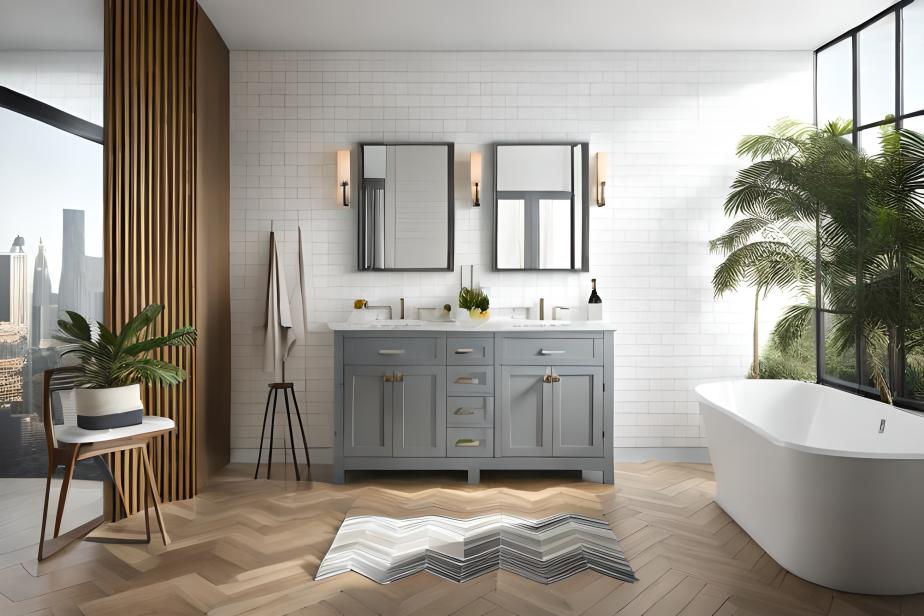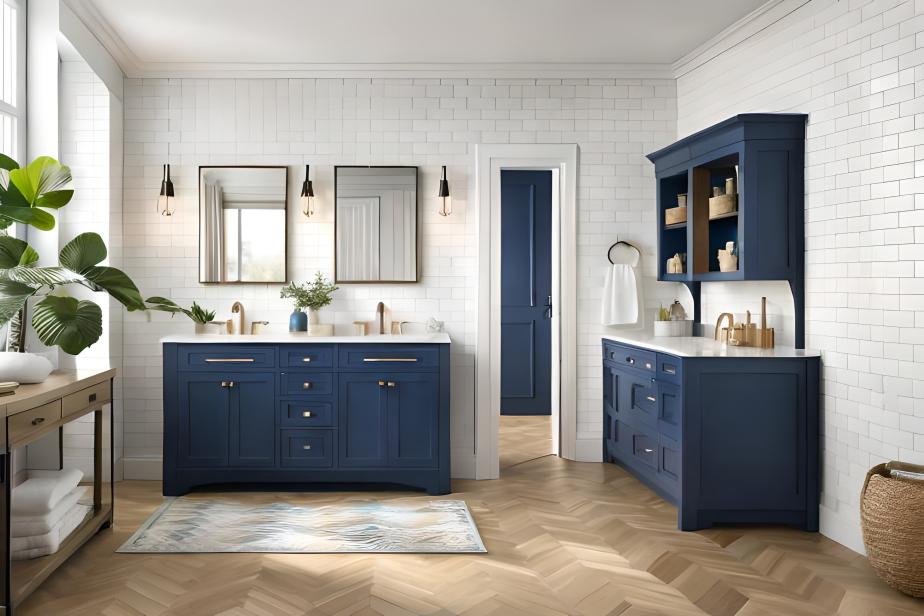The bathroom vanity isn’t just a functional piece—it’s a critical element that can dictate the style and mood of your space. Selecting the right vanity is as important as choosing the best lighting or tiles. This guide delves into finding the perfect vanity design, covering everything from timeless colors to height considerations.
What Type of Vanity is Best for a Bathroom?
Central to your bathroom’s utility and style, bathroom vanities come in diverse forms. Making an informed choice ensures you pick a design that aligns with your bathroom’s aesthetic, size, and functionality.
Freestanding Vanities
Definition: These vanities stand independently, without any need for wall support, resembling furniture. They bring elegance and sophistication reminiscent of classic European or vintage American designs.
Pros:
- Versatility: With a broad range of design options from traditional to contemporary, freestanding vanities can suit almost any bathroom style.
- Storage: Often equipped with cabinets and drawers, these vanities provide ample storage space.
- Easy Installation: No need for wall mounting, making the installation process relatively straightforward.
Cons:
- Space Consumption: Being bulkier, they can occupy more floor space, potentially making a bathroom feel smaller.
- Cleaning: The area beneath the vanity might be harder to access and clean.
Wall-mounted Vanities
Definition: As the name suggests, wall-mounted or “floating” vanities are attached directly to the wall, creating a hovering effect above the floor.
Pros:
- Modern Aesthetics: They impart a contemporary and sleek look, making the room feel more spacious by showing more floor space.
- Easy Cleaning: The space beneath is accessible, simplifying cleaning the floor underneath.
- Customizable Height: You can choose the height to mount the vanity, making it adaptable to different user preferences.
Cons:
- Installation: Requires a sturdier wall mounting, ensuring the wall can bear the vanity’s weight, especially when loaded with bathroom essentials.
- Limited Storage: Some designs might offer less storage than their freestanding counterparts.
Corner-mounted Vanities
Definition: Specifically designed to fit into a corner, these vanities are perfect solutions for bathrooms with unusual layouts or limited space.
Pros:
- Space Optimization: Utilizes potentially wasted corner spaces, maximizing the room’s utility.
- Compact Design: Ideal for powder rooms or small bathrooms where space is at a premium.
Cons:
- Limited Counter Space: Due to their compact nature, they often offer less countertop space, which might not be ideal for those who require ample room for toiletries.
- Design Limitations: Fewer design options are available than freestanding or wall-mounted vanities.
When finalizing your vanity choice, it’s also advisable to consider additional enhancements. For instance, the Table Desk Vanity Makeup Mirror can be an excellent addition, reflecting light and elegance into your space.
What Colour Vanity is Timeless?
The color palette you choose for your bathroom vanity plays a significant role in setting the overall ambiance of the space. While some homeowners are tempted by fleeting trends, opting for timeless colors can ensure that your bathroom retains a classic elegance for years.
Popular Current Trends:
Deep Blues:
- Overview: A deep blue vanity can create a sense of serenity and depth in a bathroom. Its rich undertones can evoke feelings of the ocean or evening sky.
- Pairing Suggestions: Deep blue pairs beautifully with gold or brass fixtures and white or light-colored countertops, creating a luxurious and sophisticated look.
- Ideal Settings: Best suited for well-lit, spacious bathrooms where the color can shine without overwhelming the space.
Matte Blacks:
- Overview: Matte black exudes modernity and boldness. It’s a stark departure from traditional bathroom colors and can be a minimalist or contemporary design centerpiece.
- Pairing Suggestions: Matte black vanities look striking against light-colored walls and floors. Metallic fixtures, especially copper or gold, can elevate the overall aesthetic.
- Ideal Settings: Especially captivating in ultra-modern settings or bathrooms with a monochromatic theme.
Earthy Browns and Taupes:
- Overview: Earth tones are inherently warm and welcoming. Browns and taupes can make a bathroom feel grounded and connected to nature.
- Pairing Suggestions: Combine greenery, wooden elements, and beige or cream textiles for a harmonious look.
- Ideal Settings: Perfect for those seeking a natural, spa-like ambiance in their bathroom.
Timeless Classics:
Whites:
- Overview: White is synonymous with cleanliness—imperative for a bathroom setting. A white vanity provides a sense of purity, openness, and rejuvenation.
- Pairing Suggestions: Virtually any color pairs well with white. For a minimalist look, opt for monochrome accents, or introduce wood and plants for a hint of nature.
- Maintenance Note: While white is versatile, it can show stains more easily, so regular upkeep is essential.
Grays:
- Overview: Gray strikes a balance between being neutral and having character. It offers the sleekness of modern design while remaining unobtrusive.
- Pairing Suggestions: Grays work well with marble countertops and silver fixtures and can be livened up with pops of colors like blues or purples in decor items.
Muted Beiges:
- Overview: Beige is warm, cozy, and inviting without being overpowering. It’s a subtle color that brings warmth to the bathroom.
- Pairing Suggestions: Harmonizes well with wooden accents, white fixtures, and pastel-colored textiles.
While selecting a vanity color, consider the long-term appeal and how it will blend with changing decor elements. Additionally, accessorizing can breathe life into a static color palette. The vibrant Bathroom Vanity Tray can be a stylish organizer, introducing texture and contrast to your chosen vanity color.
Are Vanities Still in Style?
Bathroom vanities, once a symbol of luxury and status during the Victorian era, have evolved significantly over the centuries. Their sustained significance in modern homes isn’t just due to nostalgia; it’s a testament to their inherent utility and capacity to elevate a bathroom’s aesthetic. As contemporary living has shifted towards blending the old with the new, bathroom vanities have adopted a more versatile design approach.
The Historical Essence:
During the Victorian era, bathroom vanities symbolized opulence. Typically made of sturdy woods and intricate carvings, they were more than functional fixtures—they were a statement. This sentiment persists today, albeit adapted to reflect modern tastes.
Current Trends in Vanity Designs:
Minimalistic Designs:
- Overview: The “less is more” philosophy has taken over interior design, and bathroom vanities haven’t been spared. Sleek lines, unembellished surfaces, and an emphasis on function are characteristic of this trend.
- Why It’s Popular: Minimalistic designs provide a clutter-free look, giving the bathroom a spacious and airy feel. It’s especially beneficial for smaller bathrooms where space is at a premium.
- Styling Tips: Neutral color palettes, understated hardware, and simple mirror designs usually complement this vanity style.
Open Shelving Concepts:
- Overview: Moving away from the traditional cabinet and drawer model, open shelving offers a more relaxed and accessible storage solution.
- Why It’s Popular: Open shelving encourages organization, as items are on display. It also offers easy access to frequently used items.
- Styling Tips: Use stylish baskets or containers to keep items organized. Introduce a mix of decorative elements like candles or plants to break the monotony of useful items.
Integrated Sinks:
- Overview: These are countertops that flow seamlessly into the sink, made of the same material, eliminating the traditional distinction between the two.
- Why It’s Popular: Integrated sinks offer a streamlined look and are easier to clean due to the absence of seams or crevices.
- Material Choices: Popular materials for integrated sinks include quartz, marble, and solid surface composites.
Maximizing Function with Accessories:
While the vanity is essential, the accessories paired with it can significantly enhance its functionality and style. For instance, the 2-Tier Corner Bathroom Counter Organizer offers an ideal solution for storing and categorizing your essentials. Its design is practical and to the current trend of keeping spaces decluttered while exuding modern elegance.
How Tall is a Modern Bathroom Vanity?
Bathroom vanity height has, over the years, seen shifts in standards, largely due to evolving ergonomic understandings and changing user preferences. Traditionally, vanities echoed the heights of other furniture items but have since become taller to accommodate modern needs.
Historical Context:
Historically, bathroom vanities took inspiration from regular furniture pieces, often designed without specific considerations for tasks like washing hands or face. Consequently, the typical height used to hover around 30-32 inches.
The Shift Towards Taller Vanities:
Today, comfort and functionality play pivotal roles in bathroom design. With this evolution, the standard height for bathroom vanities has increased. Modern designs are typically around 36 inches tall, sometimes even reaching 40 inches.
Advantages of Taller Vanities:
Ergonomics:
- Reduced Strain: A taller vanity reduces the need to bend over as much when washing, making it easier on the back and neck. This is especially beneficial for taller individuals who might otherwise experience discomfort with a lower counter.
- Leg Room: A slightly elevated vanity can offer more legroom, making seated tasks, such as makeup application, more comfortable.
Enhanced Storage:
- A taller vanity usually translates to more vertical storage space. The additional height can help accommodate more items and declutter the bathroom surface, whether larger drawers or extra shelving beneath the sink.
Modern Aesthetics:
- Taller vanities can give a contemporary bathroom look, especially with other modern elements.

Choosing the Right Vanity Height:
The “right” vanity height is subjective and depends largely on the needs and preferences of its users:
- Personal Height: A bathroom used primarily by taller individuals might benefit from a taller vanity, while one used by shorter people or children might necessitate a lower height.
- Primary Users: If children are the primary users of a bathroom, a lower vanity (or a step stool) might be more appropriate. On the other hand, adult-exclusive bathrooms can comfortably adopt the modern taller standard.
- Custom Solutions: For households with diverse needs, adjustable or custom-height vanities can be a solution. Some designs allow height adjustment or have tiered counter spaces to cater to all family members.
Remember, the bathroom is a personal space, and its design should cater to its user’s specific needs and comforts. It’s always a good idea to measure the space, visualize the usage, and even try out vanities of different heights before sett lying on a final choice.
Conclusion
Finding the right bathroom vanity can transform your space from ordinary to extraordinary. By considering the type, color, and height best fits your needs, you’ll select a piece that complements your style and stands the test of time. As you refine your bathroom’s look, don’t forget to add the final touches with top-tier products like the Table Desk Vanity Makeup Mirror, 2-Tier Corner Bathroom Counter Organizer, and Bathroom Vanity Tray. These additions ensure that your bathroom is as functional as stylish, leaving a lasting impression on all who enter.




